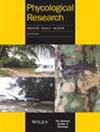基于形态学、生态学和分子分析的大韩民国 Klisinema koreana sp.
IF 1
4区 生物学
Q2 MARINE & FRESHWATER BIOLOGY
引用次数: 0
摘要
Klisinema属(Desertifilaceae,Desertifilales)在全世界仅有一个物种,即Klisinema persicum,该物种发现于高辐射地区温泉(50°C)周围的土壤中。研究人员从韩国采集了属于 Klisinema 属的单丝蓝藻,并通过形态学、生态学和分子分析对培养样本进行了研究。韩国的 K. persicum 和 Klisinema koreana 都是淡水砾石中的附生物种,与之前报道的 K. persicum 具有不同的生态特征。形态分析结果表明,K. koreana 的细胞质角质化,这一特征也是在韩国发现的 K. persicum 中新观察到的。此外,与 K. persicum 相比,K. koreana 的宽度/长度比更大,而且这两个物种都具有不规则的类囊体排列。此外,通过对 16S rRNA 进行系统进化分析,Klisinema 属形成了一个单系,K. koreana 菌株与 K. persicum 菌株明显分开,形成了一个系统进化树。此外,比较 16S-23S 内部转录间隔区的二级结构,K. koreana 与 K. persicum 存在结构差异,尤其是在 Box-B 螺旋结构上。因此,Klisinema koreana sp.本文章由计算机程序翻译,如有差异,请以英文原文为准。
A study of Klisinema koreana sp. nov. (Desertifilaceae, Cyanobacteria) from the Republic of Korea based on morphological, ecological and molecular analyses
Genus Klisinema (Desertifilaceae, Desertifilales) has only one species, Klisinema persicum, reported worldwide, and this species was found in soils around thermal springs (50°C) of high radiation regions. Simple filament cyanobacteria belonging to the genus Klisinema were collected from Korea, and cultured samples were studied through morphological, ecological and molecular analyses. Both Korean K. persicum and Klisinema koreana were found as epilithic species in freshwater gravel, which have different ecological characteristics from previously reported K. persicum. As a result of morphological analysis, keritomized cytoplasm was observed in K. koreana, and this feature was also newly observed in K. persicum that was discovered in Korea. In addition, K. koreana has a larger width/length ratio compared to K. persicum, and both species have an irregular thylakoid arrangement. Furthermore, as a result of phylogenetic analysis of 16S rRNA, the genus Klisinema formed a monophyletic lineage, and K. koreana strains were clearly separated from K. persicum strains to form a phylogenetic tree. Moreover, when comparing the secondary structure of the 16S–23S internal transcribed spacer region, K. koreana has a structural difference from K. persicum, especially in the structure of the Box-B helix. Therefore, Klisinema koreana sp. nov. was proposed as a new species belonging to the genus Klisinema of family Desertifilaceae.
求助全文
通过发布文献求助,成功后即可免费获取论文全文。
去求助
来源期刊

Phycological Research
生物-海洋与淡水生物学
CiteScore
3.60
自引率
13.30%
发文量
33
审稿时长
>12 weeks
期刊介绍:
Phycological Research is published by the Japanese Society of Phycology and complements the Japanese Journal of Phycology. The Journal publishes international, basic or applied, peer-reviewed research dealing with all aspects of phycology including ecology, taxonomy and phylogeny, evolution, genetics, molecular biology, biochemistry, cell biology, morphology, physiology, new techniques to facilitate the international exchange of results. All articles are peer-reviewed by at least two researchers expert in the filed of the submitted paper. Phycological Research has been credited by the International Association for Plant Taxonomy for the purpose of registration of new non-vascular plant names (including fossils).
 求助内容:
求助内容: 应助结果提醒方式:
应助结果提醒方式:


